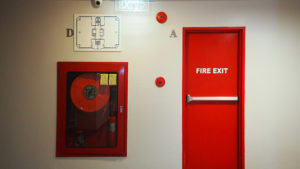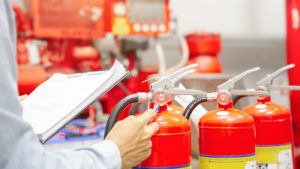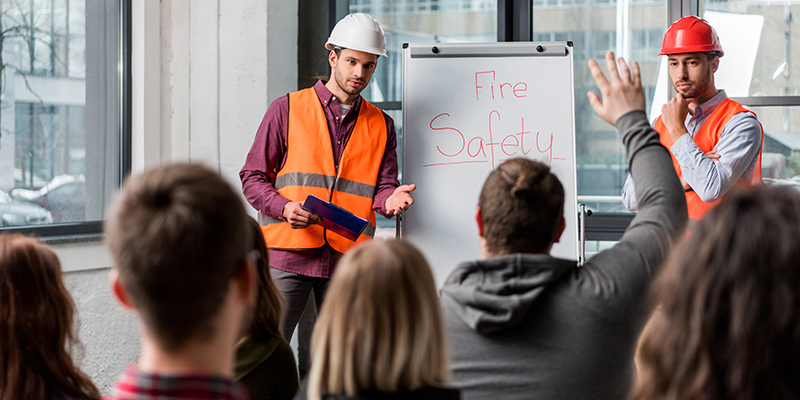Commercial building fire safety is absolutely paramount. Unfortunately, not all property owners know how to go about ensuring it.
Commercial Building Fire Safety Guidelines to Implement
Managing a commercial building comes with a plethora of responsibilities. One of these responsibilities is ensuring the safety of the building’s occupants and visitors. When it comes to commercial buildings, fire is among the largest safety risks. In fact, according to the National Fire Protection Association, more than 490,000 structure fires occurred in the United States between 2015 and 2019.
But, a majority of commercial fires are preventable. Property owners and building managers just need to pay close enough attention and put in the work. Here are the top guidelines for ensuring fire safety in commercial buildings.
1. Evacuation Planning
Commercial buildings should have and follow an emergency plan. This plan should indicate all of the exit routes occupants must use as well as the procedures for evacuation. The building’s owner or manager should make sure to have an emergency plan in writing and distribute it to all occupants.
It is imperative to train all employees on the procedures for evacuation, including any processes that involve shutting down equipment in the event of a fire. Additionally, it is also worth conducting regular fire evacuation drills to get everyone familiar with the process.
Apart from simply having a written plan, owners and managers should revisit this plan every few years or so. Commercial fire safety guidelines can change over time, and building changes can also influence evacuation procedures. As such, reviewing and updating the plan every so often will help fight obsolescence.
2. Evacuation Routes
 Having the appropriate number of evacuation routes is one of the most critical fire safety requirements for commercial buildings. The Occupational Safety and Health Administration (OSHA) requires a workplace to have at least two evacuation routes. However, this can change depending on the building’s layout, size, and occupancy.
Having the appropriate number of evacuation routes is one of the most critical fire safety requirements for commercial buildings. The Occupational Safety and Health Administration (OSHA) requires a workplace to have at least two evacuation routes. However, this can change depending on the building’s layout, size, and occupancy.
Simply having two exit routes isn’t enough, though. These routes must be free from any obstructions to facilitate the swift and safe evacuation of occupants. Additionally, the exit doors must either remain unlocked or have a delayed opening feature in accordance with the building’s alarm system.
3. Fire Prevention
In addition to an emergency plan, a written fire prevention plan is also essential for commercial building fire safety. While evacuation plans come in handy when an actual fire breaks out, fire prevention plans aim to reduce the risk of fires.
The contents of a fire prevention plan will depend on the type of commercial building. Generally, though, it should include guidelines on how to properly store and clean up flammable items or liquids, procedures for maintaining and controlling potential ignition sources, and the equipment needed to keep hazards in check.
As with evacuation plans, it is imperative to train all employees on fire prevention, particularly the risks associated with their specific positions.
4. Fire Suppression
Commercial buildings should have a fire suppression system. This system should be able to detect fires, turn on alarms, and activate sprinklers in the areas affected. Typically, these systems have different alarms for different purposes. There’s the usual fire alarm alerting occupants of a fire, and then there’s a special alarm that goes off right before the sprinkler activates.
A fire suppression system is different from a normal sprinkler system. While the latter usually disperses water, the former disperses special gas or powders to extinguish flames. Many commercial facilities favor fire suppression systems because water can damage certain types of materials and property. For instance, an office building with a lot of electronics would prefer a fire suppression system over a fire sprinkler system.
Managers should make sure to service fire suppression systems regularly and according to commercial building fire safety requirements. This usually involves hiring a professional to inspect and maintain the system.
5. Fire Extinguishers
 Having a fire suppression system or sprinkler system isn’t enough. Commercial buildings should also have fire extinguishers. More precisely, buildings should have the appropriate number and type of extinguishers as per commercial building fire extinguisher requirements.
Having a fire suppression system or sprinkler system isn’t enough. Commercial buildings should also have fire extinguishers. More precisely, buildings should have the appropriate number and type of extinguishers as per commercial building fire extinguisher requirements.
OSHA requires fire extinguishers located within a travel distance of 75 feet or less. There must also be fire extinguishers near exits. This eliminates the need to go inside a burning building to look for extinguishers.
Employees must know how to operate fire extinguishers. As such, this should be a part of their fire safety training. Moreover, managers should ensure that all extinguishers receive regular maintenance. This way, they always remain in proper working condition.
Most Common Commercial Building Fire Code Violations
Fire codes can vary depending on the state or even local area. But, there are several fire codes that remain consistent across different locations. And, with that, some fire code violations are more common than others.
1. Blocked Exits
All exit routes and doors should be free of obstructions to let occupants evacuate quickly. But, there are surprisingly a lot of commercial buildings that have blocked exits or passages. This is especially true in busy workplaces, where boxes of files and goods are left lying around.
2. Missing or Faulty Emergency Lights and Exit Signs
When a fire breaks out, people have a tendency to panic. Smoke can make it difficult to see, and electricity usually gets cut off. In the midst of chaos, it can be hard to exercise good judgment or common sense. Occupants can even get lost in a building where they spend most of their days in.
As such, it is important to have properly lit exit signs and emergency lights. These will make it easier for occupants to navigate through the confusion and get themselves to safety.
Make sure to have your emergency lights and exit signs checked regularly. Conduct a 30-minute minimum function test every month, and a 90-minute test every year. This way, you can ensure that emergency lights and exit signs remain lit for the amount of time needed to evacuate everyone.
3. Improper Use of Extension Cords
 Extension cords are designed as a temporary fix, but many buildings mistakenly use them permanently. This is one of, if not the most, common fire code violations across commercial buildings today.
Extension cords are designed as a temporary fix, but many buildings mistakenly use them permanently. This is one of, if not the most, common fire code violations across commercial buildings today.
Apart from not using them permanently, extension cords should never be attached to each other (known as daisy chaining) or run through holes in the wall. If you need a permanent fix, have an electrician install an electrical outlet instead.
4. Fire Pump or Riser Rooms as Storage
Many fire codes don’t allow buildings to store items other than fire protection equipment in fire pump rooms or riser rooms. But, a lot of buildings violate this code anyway. While these rooms may seem like the perfect additional storage space, using them as such will make it difficult for emergency personnel to gain access to important equipment. As a result, they can’t respond to fires quickly.
5. Blocked Exterior Access Points
Firefighters need clear access to fire hydrants as well as the building itself. But, oftentimes, these exterior connections and valves are blocked, and the fire department can’t respond to the emergency properly.
This is a severe fire code violation as it hinders the fire department’s rescue operations and can cause the fire to grow even larger during the time it takes to clear access points. Furthermore, it can lead to more injuries for both the building’s occupants and the firefighters themselves.
A Partner in Fire Safety and Maintenance
Fires are a major concern for commercial properties because they jeopardize the safety of occupants and can result in millions of dollars worth of damages. As such, owners and managers should take commercial building fire safety very seriously.
Consider outsourcing your maintenance needs to a reputable company like Maintenance Specialists Inc. We serve commercial properties in Charlotte and the surrounding areas. Call us today at 704.405.6000 or contact us online to get a free estimate.
RELATED ARTICLES:
- 7 Common Electrical Problems In Commercial Buildings To Keep An Eye Out For
- Thanksgiving Preventive Maintenance: Are You Thanksgiving Ready?
- Commercial Building Roof Inspection: Why Building Owners Shouldn’t Skimp On This

